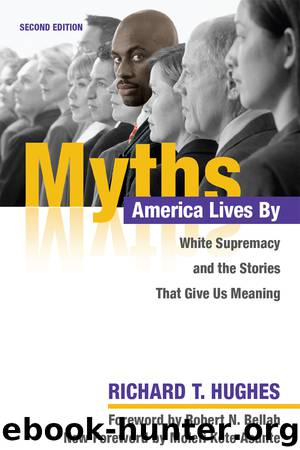Myths America Lives By by Hughes Richard T.;

Author:Hughes, Richard T.; [Неизв.]
Language: eng
Format: epub
Publisher: University of Illinois Press
CHAPTER FIVE
The Myth of the Millennial Nation
The Early National Period
The Myth of Nature's Nation dominated the Revolutionary period and quickly became a staple in the American imagination. This myth held up for emulation the virtues and perfections of a golden age that nature embodied and that stood at the beginning of time.
In the early national period, another myth—equally ahistorical—captured the American imagination. This was the Myth of the Millennial Nation.1 These two visions—Nature's Nation and the Millennial Nation—connected with one another in powerful ways, since they effectively placed brackets around human history. One looked back toward the beginning of time. The other looked forward to its end. If the Myth of Nature's Nation suggested that the United States embodied themes built into nature from the time of the Creation, the Myth of the Millennial Nation pointed in the opposite direction. This second myth suggested that the United States would illumine the globe with truth, justice, goodness, and democratic self-government and would thereby usher in a final golden age for all humankind.
In this chapter, I want to accomplish several objectives. First, I want to explore the backgrounds to the Myth of the Millennial Nation, both in the ancient world and in the American colonies. Second, I want to explore how this myth worked in the early national period. Third, I want to explore how the Myth of the Millennial Nation combined with all the other myths I have considered to this point to produce the doctrine of manifest destiny. And finally, I want to explore the ways in which the Myth of the Millennial Nation intersected with the Myth of White Supremacy.
Background
The Ancient World
The notion of a Millennial Nation ultimately derives from Jewish and Christian understandings of the end of time. Ancient Judaism nurtured a vision of a messiah who would someday appear and usher in a time when peace, justice, and righteousness would prevail. There is perhaps no biblical passage more descriptive of the messiah and the messianic age than Isaiah 11:2–6 (NIV).
The Spirit of the Lord will rest on him—
the Spirit of wisdom and of understanding,
the Spirit of counsel and of power,
the Spirit of knowledge and of the fear of the Lord—
and he will delight in the fear of the Lord.
He will not judge by what he sees with his eyes,
or decide by what he hears with his ears;
but with righteousness he will judge the needy,
with justice he will give decisions for the poor of the earth.
He will strike the earth with the rod of his mouth;
with the breath of his lips he will slay the wicked.
Righteousness will be his belt
and faithfulness the sash around his waist.
The wolf will live with the lamb,
the leopard will lie down with the goat,
the calf and the lion and the yearling together;
and a little child will lead them.
Christians believed that in Jesus Christ, the Messiah had appeared. It was, nevertheless, apparent that the advent of Jesus Christ had not transformed the world in ways that the messianic vision had predicted. Christians therefore began to apply that vision to the earth's final age, when Christ would reign triumphant.
Download
This site does not store any files on its server. We only index and link to content provided by other sites. Please contact the content providers to delete copyright contents if any and email us, we'll remove relevant links or contents immediately.
| Anarchism | Communism & Socialism |
| Conservatism & Liberalism | Democracy |
| Fascism | Libertarianism |
| Nationalism | Radicalism |
| Utopian |
The Secret History by Donna Tartt(18807)
The Social Justice Warrior Handbook by Lisa De Pasquale(12126)
Thirteen Reasons Why by Jay Asher(8767)
This Is How You Lose Her by Junot Diaz(6761)
Weapons of Math Destruction by Cathy O'Neil(6116)
Zero to One by Peter Thiel(5661)
Beartown by Fredrik Backman(5575)
The Myth of the Strong Leader by Archie Brown(5403)
The Fire Next Time by James Baldwin(5224)
How Democracies Die by Steven Levitsky & Daniel Ziblatt(5111)
Promise Me, Dad by Joe Biden(5077)
Stone's Rules by Roger Stone(5013)
100 Deadly Skills by Clint Emerson(4824)
A Higher Loyalty: Truth, Lies, and Leadership by James Comey(4822)
Rise and Kill First by Ronen Bergman(4682)
Secrecy World by Jake Bernstein(4618)
The David Icke Guide to the Global Conspiracy (and how to end it) by David Icke(4606)
The Farm by Tom Rob Smith(4421)
The Doomsday Machine by Daniel Ellsberg(4397)
